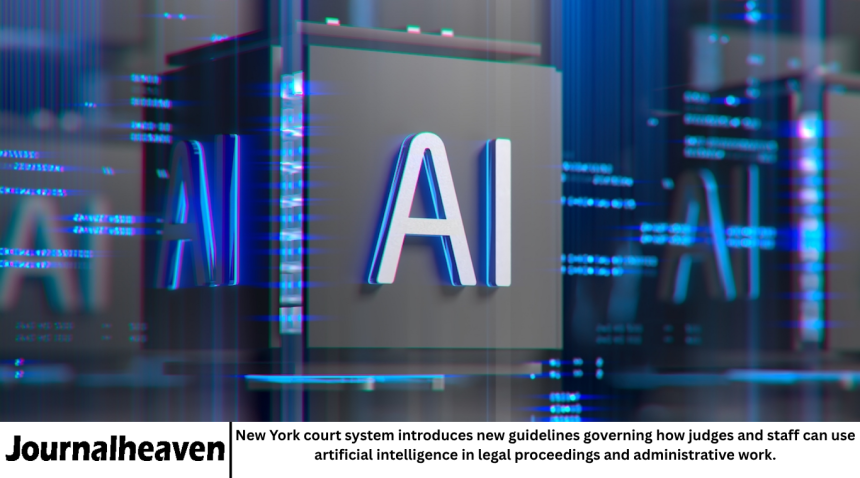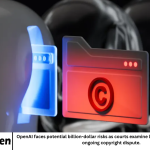The New York court system has taken a major step toward modernizing the legal process by introducing official guidelines on how judges and court staff can use artificial intelligence. The new framework aims to balance innovation with responsibility, ensuring that AI tools support the judicial process without compromising fairness, privacy, or the integrity of justice.
- The Push Toward Responsible AI in Law
- What the New Guidelines Include
- A Historic Move for U.S. Courts
- Why the Timing Matters
- Implications for Judges and Legal Staff
- Addressing the Risks of Bias and Privacy
- Reactions from the Legal Community
- Comparing with Other Jurisdictions
- The Future of AI in American Courts
- A Step Toward Digital Transformation
- Frequently Asked Questions
- Conclusion
This move reflects the growing influence of artificial intelligence across professional sectors. From law firms using AI to review documents to courts testing tools for scheduling and data analysis, technology has already started reshaping how justice is delivered. With this development, New York becomes one of the first U.S. states to formally set rules for AI use in the courtroom.
The Push Toward Responsible AI in Law
Artificial intelligence offers new possibilities for efficiency in the legal system. Automated tools can help judges analyze case history, summarize lengthy legal texts, and even draft administrative documents. However, without proper oversight, these same tools could pose risks — such as bias, inaccuracy, or overreliance on machine-generated outputs.
Recognizing these challenges, the New York Unified Court System decided to act. The new rules don’t ban AI; rather, they establish ethical boundaries and expectations for how it should be used. The goal is to ensure AI enhances, not replaces, human judgment.
What the New Guidelines Include
The new AI policy outlines several key principles designed to guide judges and staff. It emphasizes human accountability, transparency, and data protection. Below are the main highlights:
-
Human Oversight: Judges and staff must remain fully responsible for all decisions, even when AI tools assist with research or writing.
-
Transparency: Any use of AI in producing legal documents, reports, or recommendations must be disclosed when relevant.
-
Confidentiality: Court personnel are forbidden from inputting confidential or sensitive case information into AI systems unless those systems meet strict data security standards.
-
Bias Prevention: Courts must ensure AI tools are reviewed for potential bias, especially in areas involving sentencing, bail, or predictive assessments.
-
Ethical Use: AI tools should only be used to assist administrative or research functions, not to make legal determinations or influence judicial reasoning directly.
These principles aim to create a framework that promotes trust in the court’s use of emerging technology.
A Historic Move for U.S. Courts
This policy marks one of the most significant moments in the modernization of America’s judiciary. While some legal experts have debated the risks of AI in decision-making, New York’s approach demonstrates a middle ground — one that encourages innovation but demands transparency and accountability.
Chief Administrative Judge Joseph Zayas stated that the courts must “embrace technology responsibly.” He emphasized that AI, when properly managed, can help streamline administrative duties without compromising impartiality or accuracy.
The initiative comes as more legal systems around the world begin to explore the potential of AI to manage growing caseloads, optimize research, and provide better access to justice.
Why the Timing Matters
The timing of this policy is significant. Over the past year, AI models like ChatGPT, Gemini, and others have become widely available and powerful enough to generate legal summaries, analyze documents, and even mimic judicial writing styles.
This accessibility has led to both opportunity and concern. Some attorneys have been caught submitting AI-generated filings that included false citations. Others have praised AI for helping reduce research time and increase accuracy.
The New York court system’s move signals that AI can coexist with legal work — but only within structured, ethical limits. It’s a proactive measure to prevent misuse before it becomes a widespread issue.
Implications for Judges and Legal Staff
For judges, AI may soon become an everyday tool — much like online databases or digital filing systems. It can assist with tasks such as:
-
Reviewing lengthy case histories
-
Summarizing legal arguments
-
Drafting administrative correspondence
-
Organizing schedules or jury data
However, under the new rules, judges must personally verify all information generated by AI. No AI output can be accepted as legally authoritative without human review.
For court staff, the rules clarify how AI can be used for administrative efficiency while maintaining confidentiality. For example, AI might help automate scheduling or document formatting, but cannot process sensitive case information unless strict privacy standards are met.
Addressing the Risks of Bias and Privacy
One of the main concerns about AI in justice systems is bias. Algorithms trained on historical data can reflect or amplify existing inequalities — such as those seen in sentencing patterns or predictive policing.
New York’s guidelines directly address this issue. They require continuous monitoring of AI systems to ensure fairness and prohibit the use of tools that lack transparency in how they generate results.
Privacy is another major factor. The courts handle sensitive personal and criminal information, and the risk of exposing such data to third-party AI systems is significant. The guidelines prohibit inputting any non-public information into consumer-grade AI platforms without approval from the court’s technology department.
Reactions from the Legal Community
The announcement has drawn mixed reactions. Many legal experts and practitioners have praised the guidelines for setting clear expectations. They see it as an essential step toward digital modernization while protecting the justice system’s credibility.
Others have cautioned that AI tools must still be tested thoroughly before being integrated at scale. Some critics argue that even limited reliance on AI could subtly influence judges’ reasoning, particularly when time pressures lead to shortcuts.
Despite the debates, most agree that New York’s leadership on this issue will likely inspire other states to follow suit. It sets a national precedent for balancing progress with ethical responsibility.
Comparing with Other Jurisdictions
Globally, courts in countries like the United Kingdom, Canada, and Singapore have begun similar experiments with AI, though most are still in early stages.
In Canada, AI is being tested for document review and case classification. In the UK, digital tools help analyze evidence more efficiently. Singapore’s judiciary has gone a step further by launching its own AI-based system for case management.
New York’s guidelines align with these efforts but stand out for their emphasis on human accountability. By codifying these rules early, the state ensures that AI’s role remains supportive, not dominant, within the courtroom.
The Future of AI in American Courts
The New York model may soon become a blueprint for other states. As the U.S. judicial system faces rising caseloads and administrative burdens, AI could offer valuable help — from digital research assistants to smart case-tracking systems.
However, experts warn that the technology must evolve carefully. The integrity of justice depends on human reasoning, empathy, and ethical awareness — qualities AI cannot replicate.
The courts’ challenge will be maintaining this balance: using AI to improve efficiency without letting it erode the human foundation of the legal process.
A Step Toward Digital Transformation
This initiative is part of a broader transformation across the judiciary. Alongside AI, courts are investing in digital filing systems, online hearings, and data analytics tools to improve transparency and access.
Artificial intelligence is just the latest — and most complex — addition to this modernization wave. By setting early rules, New York aims to lead the nation in ensuring technology strengthens justice instead of undermining it.
Frequently Asked Questions
What are the new AI guidelines for the New York court system?
The guidelines outline how judges and court staff can use artificial intelligence responsibly while maintaining accountability, transparency, and confidentiality.
Why were these AI rules introduced?
They were created to prevent misuse, protect privacy, and ensure AI supports rather than replaces human decision-making in the judicial process.
Can AI make legal decisions under the new policy?
No. All final decisions must be made by human judges. AI can assist with research, summaries, or administrative work but cannot determine legal outcomes.
Are judges required to disclose AI use?
Yes. If AI contributes to a report, draft, or recommendation, that use must be disclosed when relevant to maintain transparency.
What risks are associated with AI in courts?
Key risks include bias in algorithms, data privacy breaches, and overreliance on AI-generated information without proper human verification.
How will the courts ensure fairness when using AI?
The policy requires continuous evaluation of AI tools to identify and prevent bias, ensuring that no party receives unfair treatment due to algorithmic errors.
Will other U.S. states follow New York’s example?
It’s highly likely. New York’s move sets a national precedent, and other states may adopt similar AI governance policies in the coming years.
Conclusion
The New York court system’s introduction of AI guidelines represents a milestone in the evolution of modern justice. By clearly defining how judges and staff can use artificial intelligence, the state ensures that progress does not come at the cost of fairness, privacy, or public trust.
As AI continues to reshape industries, the legal world must adapt — carefully and responsibly. New York’s proactive approach may serve as a model for courts nationwide, proving that innovation and integrity can coexist within the pursuit of justice.








